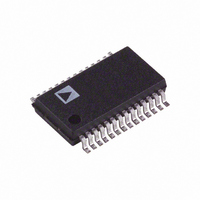AD7899ARSZ-2 Analog Devices Inc, AD7899ARSZ-2 Datasheet - Page 11

AD7899ARSZ-2
Manufacturer Part Number
AD7899ARSZ-2
Description
14-BIT BIPOLAR INPUT SINGLE SUPPLY ADC
Manufacturer
Analog Devices Inc
Datasheet
1.AD7899ARSZ-1.pdf
(16 pages)
Specifications of AD7899ARSZ-2
Number Of Bits
14
Sampling Rate (per Second)
400k
Data Interface
Parallel
Number Of Converters
1
Power Dissipation (max)
125mW
Voltage Supply Source
Single Supply
Operating Temperature
-40°C ~ 85°C
Mounting Type
Surface Mount
Package / Case
28-SSOP (0.200", 5.30mm Width)
Number Of Elements
1
Resolution
14Bit
Architecture
SAR
Sample Rate
400KSPS
Input Polarity
Unipolar
Input Type
Voltage
Rated Input Volt
2.5/5V
Differential Input
No
Power Supply Requirement
Single
Single Supply Voltage (typ)
5V
Single Supply Voltage (min)
4.75V
Single Supply Voltage (max)
5.25V
Dual Supply Voltage (typ)
Not RequiredV
Dual Supply Voltage (min)
Not RequiredV
Dual Supply Voltage (max)
Not RequiredV
Power Dissipation
125mW
Differential Linearity Error
±1LSB
Integral Nonlinearity Error
±2LSB
Operating Temp Range
-40C to 85C
Operating Temperature Classification
Industrial
Mounting
Surface Mount
Pin Count
28
Package Type
SSOP
Input Signal Type
Single-Ended
Lead Free Status / RoHS Status
Lead free / RoHS Compliant
For Use With
EVAL-AD7899CBZ - BOARD EVAL FOR AD7899
Lead Free Status / Rohs Status
Compliant
Available stocks
Company
Part Number
Manufacturer
Quantity
Price
Part Number:
AD7899ARSZ-2
Manufacturer:
ADI/亚德诺
Quantity:
20 000
EOC Mode
The CONVST signal is normally high. Pulsing the CONVST low
will initiate a conversion on its rising edge. The state of the
CONVST signal is checked at the end of conversion. Since the
CONVST will be high when this happens the AD7899 BUSY/
EOC pin will take on its EOC function and bring the BUSY/EOC
line low for one clock period before returning high again. In this
mode the EOC can be tied to the RD and CS signals to allow
automatic reading of the conversion result if required. The timing
diagram for operation in EOC mode is shown in Figure 6.
BUSY Mode
The CONVST signal is normally low. Pulsing the CONVST
high will initiate a conversion on its rising edge. The state of the
CONVST signal is checked at the end of conversion. Since the
CONVST will be low when this happens the AD7899 BUSY/
EOC pin will take on its BUSY function will bring BUSY/EOC
low, indicating that the conversion is complete. BUSY/EOC will
remain low until the next rising edge of CONVST where BUSY/
EOC returns high. The timing diagram for operation in BUSY
mode is shown in Figure 7.
BUSY/EOC
BUSY/EOC
CONVST
CONVST
CLKIN
CLKIN
DATA
DATA
RD
RD
CS
CS
t
9
t
t
t
t
10
1
1
9
t
t
10
2
THREE-STATE
THREE-STATE
t
t
CONV
CONV
Continuous Conversion Mode
When the AD7899 is used with an external clock, connecting
the CLKIN and CONVST signals together will cause the AD7899
to continuously perform conversions. As each conversion com-
pletes the BUSY/EOC pin will pulse low for one clock period
(EOC function) indicating that the conversion result is available.
Figure 8 shows the timing and control sequence of the AD7899
in Continuous Conversion Mode.
Reading Data from the AD7899
Data is read from the part via a 14-bit parallel data bus with
standard CS and RD signals. The CS and RD inputs are inter-
nally gated to enable the conversion result onto the data bus.
The data lines DB0 to DB13 leave their high impedance state
when both CS and RD are logic low. Therefore CS may be
permanently tied logic low and the RD signal used to access the
conversion result if required. Figures 6 and 7 show a timing
specification called “Quiet Time.” This is the amount of time
which should be left after a read operation and before the next
conversion is initiated. The quiet time depends heavily on data
bus capacitance but a figure of 50 ns to 100 ns is typical, with a
worst case figure of 150 ns.
t
t
3
3
t
t
6
6
t
t
t
EOC
8
8
t
t
5
5
t
t
ACQ
ACQ
QUIET
QUIET
TIME
TIME
THREE-STATE
THREE-STATE
t
t
t
t
7
7
4
4
AD7899










